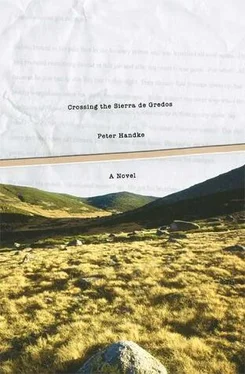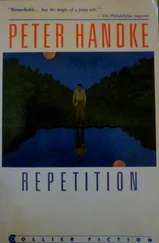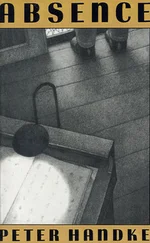“As a visage?” the author interrupted: “insofar as that word can still be used …”—She in reply: “At least for this book of ours you should describe less the mountains or the natural phenomena of the Sierra than the way the faces of people appear in the glow of the high Sierra!”
Not that the great depression, or basin, or bowl, below the uppermost rocky crest was thickly settled. And yet, on what was for now Ablaha’s final crossing, it appeared to be full of people. And that impression did not stem merely from the fact that during her previous times up/down there in Hondareda not a soul had crossed her path, or at most one to three hermits.
Altogether, this place presented fundamentally different numerical conditions, or, to put it another way, perceptions of quantity. A scant dozen figures, moving about or merely expelling visible — at long last visible — puffs of breath in the otherwise motionless stony expanse at her feet, made the impression of being “numerous.”
Earlier she had received a similar impression from seeing the mountain goats in this high-altitude depression: even when it was only a single pair, grazing at a distance from one another, the peculiar nature of the location made it appear to her like a sizable flock. Or: whenever a pair of moths fluttered around each other, it looked like a whole swarm. Even the perception of space as one gazed down toward the floor of this supersized stadium, as well as around at the slopes or tiers, was unusual. The body of water at the bottom was at one moment a mere puddle, at the next a good-size lake. The dimensions of the lone building one encountered before the Puerto de Candeleda shifted between those of a vast mountain hotel, a half-collapsed little shelter, or a toolshed on the edge of the southerly access road (or was it nothing but a former glacial trough, full of light-colored scree?). And were those swaths of snow or trails of spilled flour?
She climbed down, down, down, for an hour? for two? for half a day? and yet had hardly come any closer to the first of the rock dwellings, which had at first seemed no farther away than a hop, skip, and a jump, or an ibex’s leap. Along with the confusing — confusing? no — numerical conditions in this Hondareda went measures of distance that at first seemed unconventional, then somewhat amusing, and finally familiar from long ago, becoming, the longer one was exposed to them, just as clear and self-explanatory as the commonly used meters, kilometers, miles, or, if you will, “leguas” or “versts.” As in earlier tales, she literally and figuratively — the path was heading downhill again, steeply — saw before her, after the treeless stretch, a dwarf conifer at a distance of “a stone’s throw,” then only a “chamois’s leap,” and then one member of the observation team, strangers to the area, at “crossbow-shot distance.”
A while later, she again had in her field of vision down below King Charles V / Emperor Charles I, or the man playing or replaying him, making his way without his litter and bearers, alone, hopping “over sticks and stones” with no sign of his gout, despite his almost sixty years, also with no signs of his king- or emperorship, his mouth open “as wide as a barn door,” as when he was a child and stood there “as if to catch Spanish flies,” at what distance from her? perhaps in “paper-airplane range.” And the abandoned litter tipped over among the broom branches, how far away? Approximately a “spear’s toss,” no, “a bowshot” away. So does this make it a tale from an earlier time, too? No, from now (and now, and now).
The observer dispatched from the outside world to the new settlers’ region of Hondareda — who had just jumped out of the barely landed helicopter down below, along with several others of his ilk — noted, however, in his later report that in fact it appeared that up here people had completely taken leave of the present, by even a few gloomy degrees more decisively than in Pedrada, halfway up; a regression was at work here that set them back not merely by decades but into the far-distant past, by centuries, perhaps millennia, actually an “atavism of an atavism.”
And his report bore the heading “The Has-Beens, or” (like contemporary headline-writers for newspapers and advertisements, he had a proclivity for verbal paradoxes and wordplay): “The Mountain Castaways.”
What was accurate in his report, or whatever his testymonial (pun!) was — which is not to say that it was “true”—was that the closer to the bottom of the depression, with its lake, the people there lived or “resided,” the more “down and out” they appeared. Observers, and not only the observation teams flown in, could not escape the impression that of the mixtures and crosses of all the human races (if that word was still appropriate), the ugliest and most profoundly neglected, as well as most savagely, unsalvageably, and hopelessly battered representatives, individually or in pairs, had dragged themselves to this spot in the high Sierra and had tumbled headfirst into this enormous, rocky, prehistoric glacial pit.
Yes, that was correct: the figures in the settlement down there at the bottom corresponded to the image one had, although one should know better, of humans from prehistoric times. Were they even human beings like us, today, in the present? Did they even possess consciousness, a mental awareness as sharp and alert as ours, and our richly developed modern emotional life? Or wasn’t the sight that met our eyes at the bottom of the depression actually something we had shaken off once and for all, a deposit, the “dregs”?—even the observer would probably have been appalled at such an expression?
Yet it was only from the threshold of the dwellings down there in the valley that the people of Hondareda appeared this way to her. (Yes, it was a valley, with meadows along the outflow of the lake, and a stretch of forest, although the trees were hardly as tall as a man, along one section of the lakeshore.)
Once she had arrived and entered the settlement down there, the people became recognizable as close relatives of the unmistakably contemporary young people she had seen all over the steep slopes: their parents? More likely their grandparents, and not old at all, as well as uncles and aunts, all of whom had something foster-parent-like about them.
And if the goings-on, the doings among those dwellings, did seem odd for this day and age — again the observer had observed accurately — and were not entirely up-to-date, this hardly indicated that they had “turned their back on the present.”
It must be conceded that along with, or in addition to, the unusual surface and spatial conditions in Hondareda, something like a different kind of time was in effect. Yet it did not prevail or hold sway, but rather accompanied and undergirded normal time, as a melody and a rhythm — like everywhere else, when a person did not know what time it was by the clock, the next person would know.
The presence of a secondary type of time simply came from the fact that with every few steps down into the granite basin one encountered a different microclimate, a wind that was wintry, then warmer and vernally mild, then hot and summery, suddenly bitter cold again for a bit, until down at the bottom all these climate zones and winds were jumbled together.
And she acknowledged later that the reporter was right to some extent — when the two of them, since he, too, was out there all alone, crossed each other’s paths at some unspecified time in the wilderness beyond his observation post, close to the Candeleda Pass, and fell into conversation: it was not completely inaccurate to call the Hondareda population the “has-beens.”
The very ambiguity of the term has something to recommend it. Didn’t each of the new settlers remind one of an athlete whom an opposing player had sidelined once and for all, while this opponent had long since gone away, vanished, was no longer there to be challenged, continuing to play somewhere else? As if the has-been were not even benched but merely left shaking his fist impotently in the air?
Читать дальше












